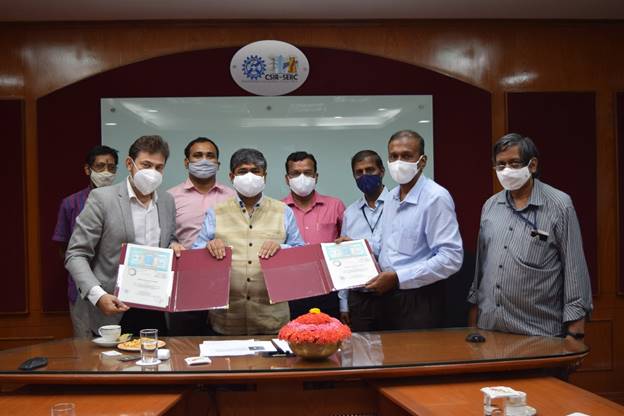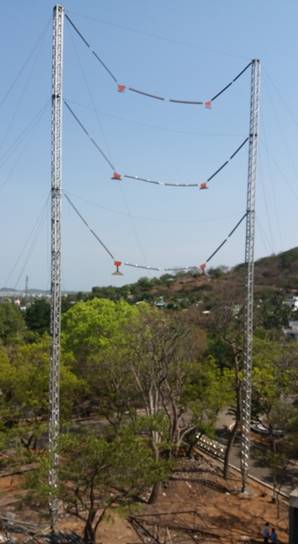The Government of India is taking preventive measures to overcome the situation of power transmission lines failures due to the falling of line towers in natural calamities such as earthquakes or cyclones. Aiming at that vision, Structural Engineering Research Centre (SERC) a laboratory-based in Chennai, Tamil Nadu, and a constituent of the Council of Scientific and Industrial Research (CSIR), developed an indigenous technology named as Emergency Retrieval System (ERS). This ERS can help for the quick retrieval of transmission of power.
The Problem/Issue (Need of ERS): In the case of natural disasters such as earthquakes, landslides, or cyclones, power supply in the affected areas got disrupted due to the fall of transmission power lines or any other cause of failure of power supplies.
The Solution which was required (Use of ERS): The immediate restoration of power by temporary, reusable structure, and alternative structure which can be assembled quickly at the disaster sites. This type of system is called as Emergency Restoration System.
CSIR developed and signed an agreement for licensing of ERS
Fulfilling the goal of Atmanirbhar Bharat and the concept of Make in India, Structural Engineering Research Centre (SERC), a CSIR laboratory based in Chennai, Tamil Nadu had developed an Indian technology. This newly developed technology can be seen as a preventive measure to overcome the situation of power failures due to power lines failures. CSIR-SERC has developed an Emergency Retrieval System (ERS), which is supposed to help for quick recovery of power transmission in the case of failure of transmission line towers due to calamities such as landslides, earthquakes, cyclones, or any man-made disruptions.
This will help the country to avoid power failures after the hitting of these calamities and it will also increase the speed of rescue operation where power supported equipment is required. Also, the laboratory signed the agreement with M/s Advait Infratech, Ahmedabad for the purpose of licensing of ERS technology.
The signatories of the Agreement
The licensing agreement for this ERS technology with Ahmedabad-based company M/s Advait Infratech was done in the presence of CSIR-SERC’s Director (Chennai), Professor Santosh Kapuria, and Chief Engineer of PSE & TD, Central Electricity Authority (New Delhi), Shri S.K Ray Mohapatra, reported by Press Information Bureau of India.

Atmanirbhar Bharat: This is the vision of the current Prime Minister of India Narendra Modi which aims to India self-reliant and make the country an important part of the global market.
Make in India: This was the initiative taken by the Government of India, in which the country aims to convert itself into a manufacturing hub by focusing more on home-made manufacturing products.
What is Emergency Retrieval System?
Emergency Retrieval System is a light-weighted and modular system. This system is structurally made up of highly stable box sections. ERS system is reusable in nature which further reduces the cost of bulk manufacturing of this system. This system provides a complete solution from member connections (individual connections). This system got verified through various rigorous structural tests. Further assembling of this system doesn’t require specialized knowledge or training or it need any special tool for installation, it can be installed by having only basic knowledge and basic tools.

The system is compact but it becomes fully functional once it is installed. This ERS is designed for a range of power lines (ranging from 33-800kV class). This system can also help in creating a disaster flexible society. ERS can be assembled quickly at the disaster sites for quick restoration of power supply.
The Significance of ERS
The Emergency Retrieval System is used as a temporary support structure which can help in the restoration of power supply due to collapse of power transmission line towers caused during natural calamities such as earthquake, cyclones, landslides, or any disruptions caused due to human error. The permanent restoration of power supply at disaster sites usually takes several weeks. This system can help in the restoration of power in two-three days. ERS system can be assembled quickly at disaster sites for urgent restoration of power.
This is why this indigenous development of the Emergency Retrieval System is quite significant as the failure of power transmission tower lines heavily impacts the lives of common peoples. Such failures also cause huge monetary loss of the Power generating companies. And there is a fact that the more the outrage duration is more will be the losses for the power companies, so this leads us to the conclusion that time is a crucial factor in reinstating the damaged power transmission towers.
Previously ERS systems were imported
Before the development of this indigenous technology made by CSIR-SERC, these systems were used to be imported. The relative costs of these Emergency Retrieval Systems are very high due to high demand and a lesser number of manufacturers across the world. This newly developed technology will not only help in the quick recovery of power but will also help in reducing the cost of the Emergency Retrieval System by 40% and will become an import substitute. This will fulfill the vision of our Prime Minister Narendra Modi of becoming self-reliant (Atmanirbhar) and Make in India. This will also present our country as the manufacturer of the ERS system for the first time.
This system has a huge demand in India, SAARC nations, and African countries. As there is high demand in our country as well as other nations, this development can be seen as an important milestone achieved while moving in the forward direction with an aim of Atmanirbhar Bharat and Make in India.

